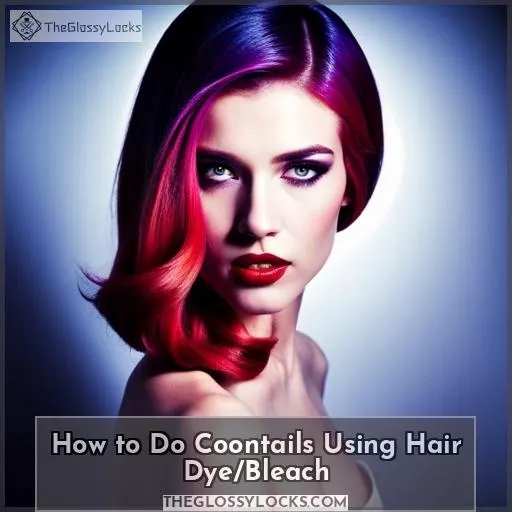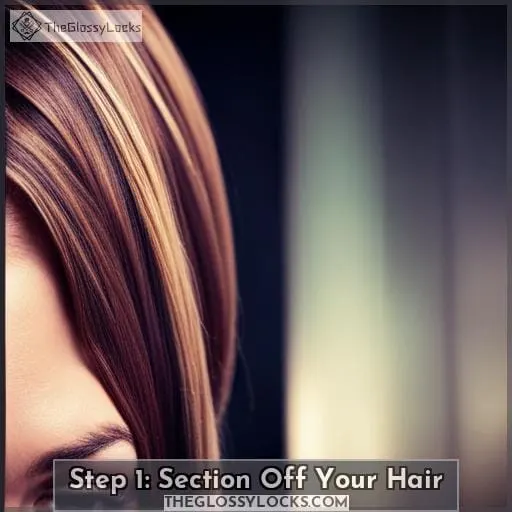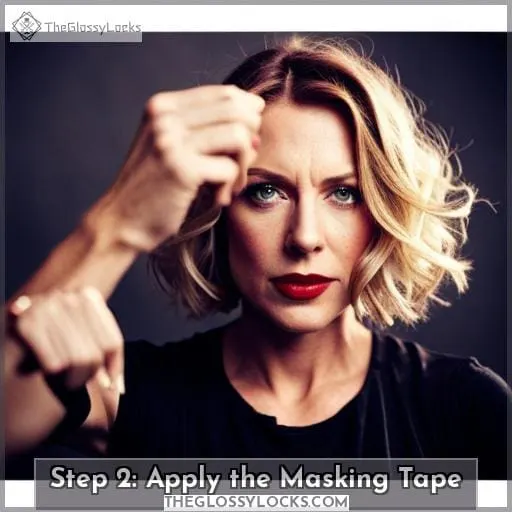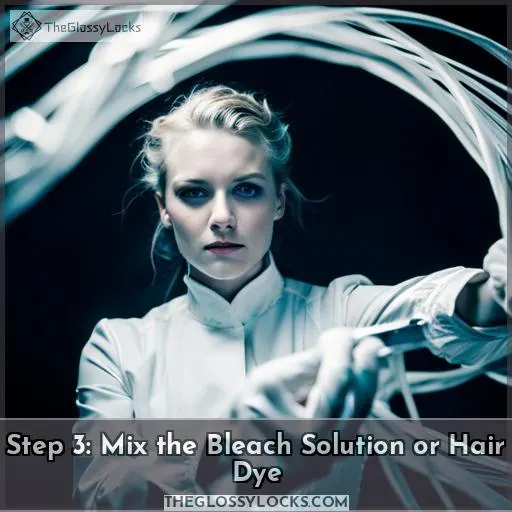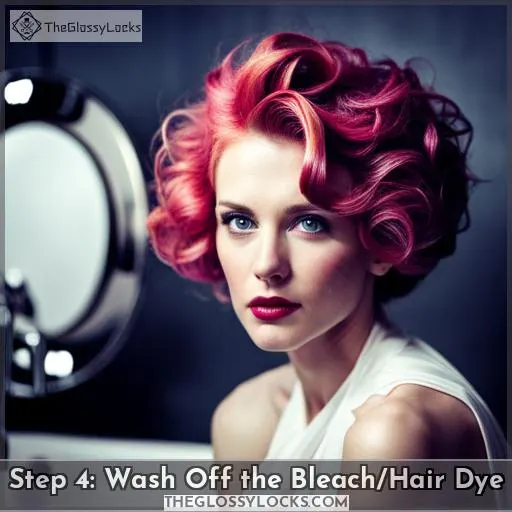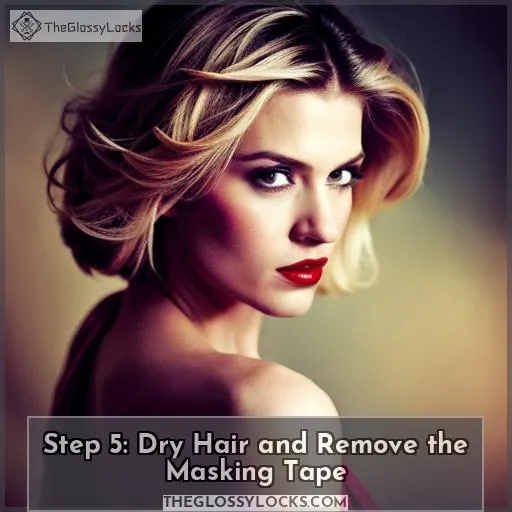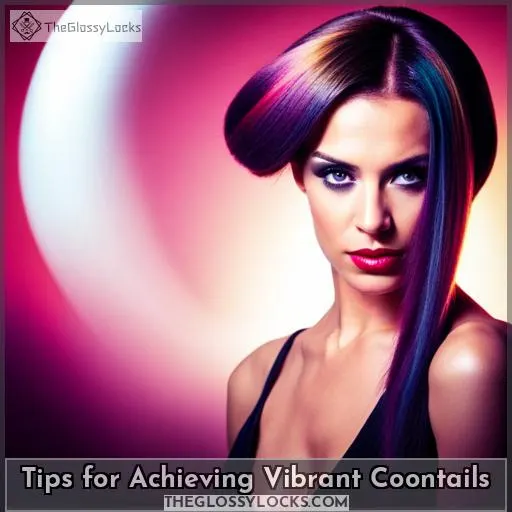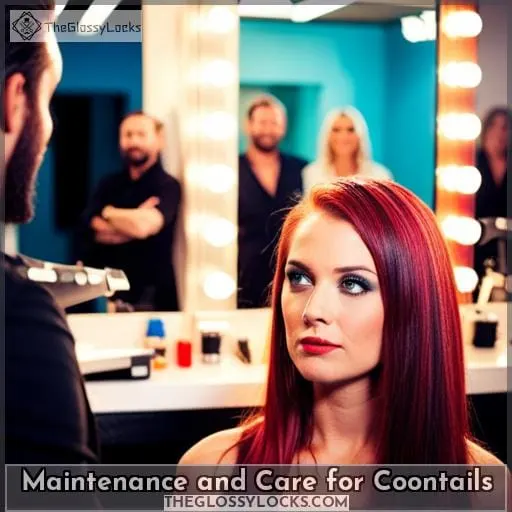This site is supported by our readers. We may earn a commission, at no cost to you, if you purchase through links.
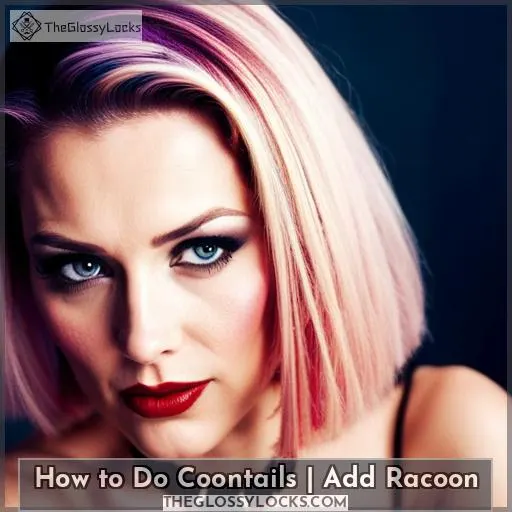
In this guide, we’ll show you step-by-step instructions on how to add raccoon-inspired streaks of color to your locks. From sectioning off your hair and applying the masking tape, to mixing the bleach solution or dye and achieving vibrant results – we’ve got you covered.
Unleash your inner rebel and master the art of coontails today!
Table Of Contents
- Key Takeaways
- How to Do Coontails Using Hair Dye/Bleach
- Step 1: Section Off Your Hair
- Step 2: Apply the Masking Tape
- Step 3: Mix the Bleach Solution or Hair Dye
- Step 4: Wash Off the Bleach/Hair Dye
- Step 5: Dry Hair and Remove the Masking Tape
- Tips for Achieving Vibrant Coontails
- Maintenance and Care for Coontails
- Frequently Asked Questions (FAQs)
- Conclusion
Key Takeaways
- Sectioning and Planning: Precise color application starts with well-planned sections and consideration of contrasting shades for vibrant results.
- Precision in Application: Use masking tape as a stencil for clean dye application, following instructions meticulously and protecting the skin with gloves.
- Thorough Cleaning and Hydration: Hydrate colored hair with thorough shampooing, conditioning, and careful rinsing to remove residue and maintain color vibrancy.
- Styling Tips and Maintenance: Experiment with styling tools, invest in color-safe products, and opt for regular maintenance to sustain the coontail’s appeal.
How to Do Coontails Using Hair Dye/Bleach
To achieve coontails using hair dye or bleach, you’ll frequently need to section off your hair and apply masking tape. This technique ensures that the color is applied to specific strands without bleeding onto other areas of your hair.
When it comes to selecting the right color for your coontails, consider contrasting shades that complement your base hair color for a bold and eye-catching look.
For those with curly or wavy hair, it’s recommended to straighten your locks before applying the dye or bleach as this will make it easier to work with and create cleaner sections.
Additionally, if you have dark-colored hair and want vibrant coontails without bleaching all of your tresses, there are options available such as temporary dyes or raccoon extensions which can be easily clipped on and removed as desired.
By following these tips and techniques, you’ll be able to confidently rock stunning coontails that showcase both style mastery and personal liberation in no time at all!
Step 1: Section Off Your Hair
To begin creating coontails, you’ll need to section off your hair. This step is crucial in achieving the desired color placement and ensuring a clean and organized application process.
Start by using a comb to divide your hair into manageable sections based on the thickness of the strands you want to dye or bleach. You can choose to create thin or thick sections depending on your preference for boldness or subtlety.
Color options for coontails are endless, allowing you to express your individuality and style. From vibrant neon hues like electric blue and hot pink inspired by scene hair trends, to more natural shades like caramel brown or golden blonde that add depth and dimension, there’s something for everyone.
When it comes to styling techniques for coontails, some popular choices include straightening the dyed strands with a flat iron for a sleek look that accentuates color contrast against natural roots. Another option is curling those strands using either heat tools or heatless methods such as braiding overnight.
Trend evolution has seen celebrities embracing raccoon tail hairstyles over time with various interpretations of this edgy look popping up on red carpets worldwide.
Doing DIY coontails may present challenges if not approached correctly; precision is key when applying masking tape around each section before bleaching/dyeing begins – mistakes might result in uneven coloring patterns which could be difficult (or impossible) to fix afterward! It’s essential always read instructions thoroughly beforehand to ensure successful results without any mishaps along the way.
Step 2: Apply the Masking Tape
Now, apply the masking tape to secure the sections of hair in place. This step is crucial for achieving precise and clean coontails. The masking tape acts as a stencil, ensuring that the bleach or dye is applied only to the desired areas of your hair.
Before applying the tape, make sure your hair is fully sectioned off according to your desired design. Take into consideration factors such as thickness and placement of each section.
When applying the masking tape, be careful not to pull or tug on your hair too tightly as it may cause discomfort or damage. Gently press down on each piece of tape along its edges to ensure it adheres firmly onto your hair.
The artistry lies in how you arrange and shape these tapes – feel free to get creative! Experiment with different patterns and angles for unique designs that reflect your personal style.
Once you have securely taped off every section intended for bleaching or dyeing, move on confidently knowing that precision techniques will guide you towards achieving stunning coontail results!
Step 3: Mix the Bleach Solution or Hair Dye
Next, mix the bleach solution or hair dye to prepare for applying it to your hair.
When it comes to coontails, you have a variety of color options to choose from. DIY techniques have evolved over time, allowing you the freedom and power to create your own unique raccoon tail hairstyle.
Take inspiration from celebrity coontails and explore different styling accessories that can enhance your look even further. Whether you opt for a vibrant emo hair style or a more subtle approach, mixing the right hair dye or bleach solution is crucial in achieving desired results.
When preparing the mixture, carefully follow instructions provided with the chosen product. Ensure that you wear gloves throughout this process as some dyes may stain skin temporarily if not properly protected against contact.
Mixing colors requires precision and attention; make sure all components are thoroughly combined before application onto designated sections of your pre-sectioned off hair strands.
Remember that experimentation is key when creating coontails – embrace trend evolution while embracing liberation through personal expression!
Step 4: Wash Off the Bleach/Hair Dye
After allowing the bleach or hair dye to process for the recommended amount of time, it’s time to wash off the product from your hair.
Properly rinsing out the bleach or hair dye is crucial in achieving vibrant and long-lasting coontails. Follow these rinse techniques to ensure optimal results:
- Start by thoroughly wetting your hair with lukewarm water.
- Gently massage a clarifying shampoo into your scalp and throughout your hair, focusing on areas where you applied the bleach or dye.
- Rinse out all of the shampoo until the water runs clear, ensuring that no residue remains.
- Apply a nourishing conditioner specifically designed for color-treated hair to protect and hydrate your strands.
Properly washing off any remaining bleach or color won’t only help prevent further damage but also minimize color fading over time while maintaining healthy-looking tresses.
It’s essential to prioritize protecting both yourself and your newly colored coontails during this step as well—always wear gloves when handling chemicals like bleaches or dyes in order to avoid allergic reactions on sensitive skin.
By following these steps carefully, you can confidently achieve stunning coontails without compromising style nor safety!
Step 5: Dry Hair and Remove the Masking Tape
Once you have washed off the bleach or hair dye, it’s time to dry your hair and remove the masking tape.
Start by gently patting your hair with a towel to remove excess moisture. Avoid rubbing vigorously as this can cause frizz and damage to your strands.
To ensure proper drying and styling of coontails, employ blow-drying techniques for maximum control over the direction of your locks. Use a round brush while blow-drying each section separately to add volume and create smoothness.
When removing masking tape, take caution not to pull or tug on your hair too forcefully as this can lead to breakage or tangles. Carefully peel back each piece of tape from top down towards the ends, ensuring that no residue is left behind.
Now that you’ve removed all masking tape from your newly colored strands, take some time experimenting with different styling options for coontails – whether it be sleek straightened look using flat iron or playful curls achieved through curling wand.
Remember that regular maintenance is key in preserving color vibrancy and overall health of treated hair.
To protect water quality, avoid washing out any leftover bleach/dye chemicals into drains where they may enter aquatic environments. Bleach/dye compounds contain ingredients such as ammonia, nitrites, and heavy metals which are toxic substances causing harm when introduced into bodies of waters.
These pollutants contribute nutrient-rich runoff leading to eutrophication: excessive growth of aquatic plants, resulting in decreased dissolved oxygen levels harming fish habitat and waterfowl feeding areas.
Proper disposal of used containers is recommended to reduce the risk of environmental contamination. Choose eco-friendly products whenever possible to promote sustainability and preservation of Earth’s natural resources.
Tips for Achieving Vibrant Coontails
Now that you’ve successfully dried your hair and removed the masking tape, let’s dive into the crucial tips for achieving vibrant coontails that truly make a statement.
- Color Combinations: Experiment with bold and contrasting color choices to make your coontails pop. Think outside the conventional palette for a truly unique look.
- Styling Options: Explore various styling techniques to accentuate your coontails. Whether it’s sleek and straight or embracing your natural waves, the possibilities are endless.
- Temporary Alternatives: Test the waters with temporary hair dyes or color sprays. It’s a risk-free way to try out different looks before committing to a permanent change.
- Hair Health: Prioritize the health of your hair by using nourishing products. Deep conditioning treatments and regular trims will keep your tresses in top condition.
- Celeb Coontails: Draw inspiration from celebrities rocking coontails. Embrace the edgy allure of this trend while adding your personal touch.
Elevate your coontail game with these tips, and watch heads turn as you flaunt your unique style.
Maintenance and Care for Coontails
To maintain vibrant coontails, regularly nourish your colored strands with specialized color-safe shampoo and conditioner, ensuring longevity and preserving the bold raccoon-inspired aesthetic.
Beyond basic care, explore styling techniques that enhance the contrast and appeal of your coontails.
Consider incorporating trendy accessories to elevate your look, adapting to seasonal variations for a fresh and dynamic appearance.
Embrace the versatility of coontails by experimenting with different hairstyles and color combinations.
To protect the vividness of your coontails, invest in color protection products and follow a consistent hair care routine.
Here’s a quick reference guide to assist you in maintaining your coontails:
| Hair Care | Tips and Tricks |
|---|---|
| Shampoo | Use color-safe formulations |
| Conditioner | Opt for deep conditioning treatments |
| Accessories | Experiment with bold accessories |
| Styling | Explore diverse hairstyles |
| Seasonal | Adjust colors based on seasonal trends |
By incorporating these practices, you’ll ensure that your coontails remain a striking and enduring expression of your style while prioritizing the health and vibrancy of your hair.
Frequently Asked Questions (FAQs)
What are the different variations of coontail hairstyles?
There are various ways to achieve coontail hairstyles.
You can opt for a bold and vibrant look by dyeing all of your hair in flamboyant colors or go for a more subtle approach with temporary hair dyes or extensions.
Can coontails be done on short hair without extensions?
Yes, coontails can be achieved on short hair without extensions.
By strategically dyeing or bleaching sections of your hair, you can create the desired contrast and achieve the stylish coontail look.
What are the pros and cons of getting coontails?
Coontails offer an eye-catching and stylish hair color option, customizable to your liking. They work for any hair length but require maintenance. However, they may not be suitable for all hair types and can potentially damage the hair if not done correctly.
How long do coontails typically last before needing to be redone?
Coontails typically last for about 2-4 weeks before needing to be redone. The longevity depends on factors such as:
- Hair care routine
- Color intensity
- individual hair growth
Regular touch-ups will help maintain the vibrant look of coontails.
Are there any specific hair types that coontails may not work well with?
Certain hair types, such as very fine or brittle hair, may not be the most compatible with coontails.
It’s important to consider your hair’s health and texture before attempting this style for optimal results.
Conclusion
Elevate your style with coontails, the bold and rebellious trend that transforms your hair into a vibrant statement. By following our step-by-step guide on how to do coontails, you can easily add raccoon-inspired streaks of color to your locks.
From sectioning and taping to mixing the perfect bleach or dye solution, our instructions ensure a seamless process. Unleash your inner rebel, and with a touch of creativity, master the art of coontails for an edgy and vibrant look that truly stands out.

